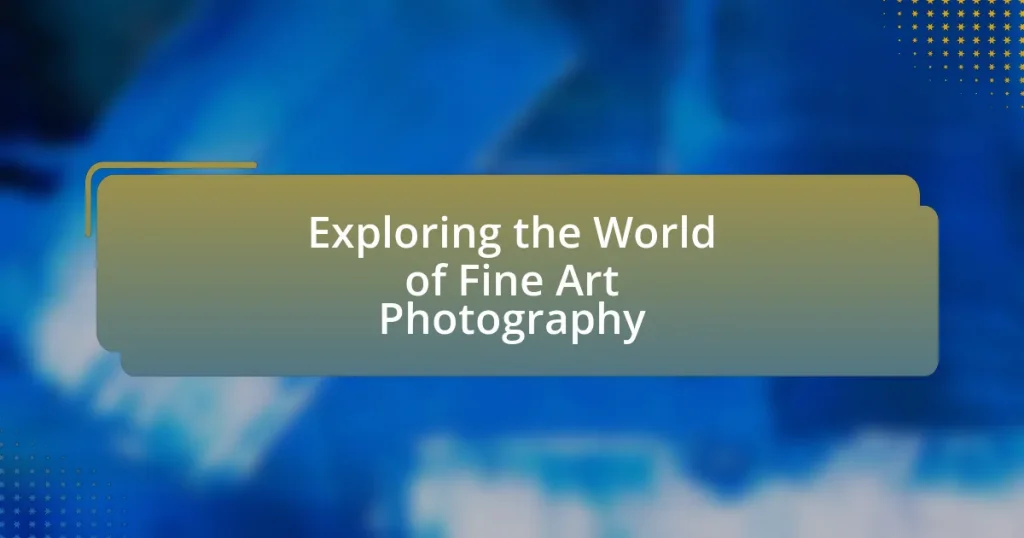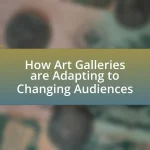Fine art photography is a genre that prioritizes artistic expression and aesthetic value over documentary or commercial purposes. This article explores the defining characteristics of fine art photography, including its focus on the photographer’s vision, the techniques used, and the historical influences that shaped its development. Key themes such as identity, nature, and social commentary are examined, along with the emotional impact of the work on viewers. Additionally, the article provides guidance for aspiring fine art photographers on developing their personal style, essential equipment, and best practices for showcasing their work effectively.
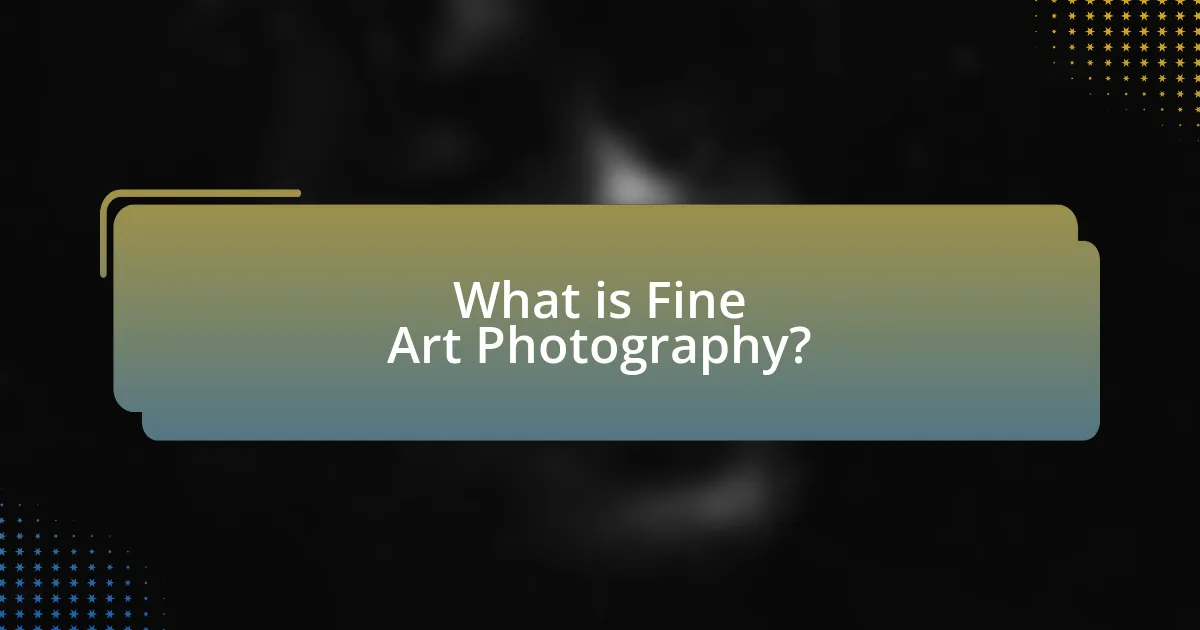
What is Fine Art Photography?
Fine art photography is a genre of photography that emphasizes artistic expression and aesthetic value rather than purely documentary or commercial purposes. This form of photography often involves the photographer’s vision and interpretation, aiming to convey emotions, concepts, or narratives through visual imagery. Fine art photographers typically create images that are intended for display in galleries or exhibitions, showcasing their unique perspectives and creativity. The distinction between fine art photography and other types of photography lies in its focus on the artistic intent behind the work, as evidenced by the presence of fine art photography in renowned institutions like the Museum of Modern Art, which features works that prioritize artistic expression over functional representation.
How does Fine Art Photography differ from other photography genres?
Fine Art Photography differs from other photography genres primarily in its intent and purpose, focusing on the expression of the artist’s vision rather than merely capturing reality. While genres like portrait, landscape, or documentary photography aim to document or represent subjects as they are, Fine Art Photography emphasizes creativity, conceptual ideas, and aesthetic value. This genre often involves a deliberate process of planning, composition, and post-processing to convey deeper meanings or evoke emotions, distinguishing it from more straightforward photographic practices. For instance, artists like Ansel Adams and Cindy Sherman have utilized Fine Art Photography to explore themes of nature and identity, respectively, showcasing how the genre can serve as a medium for personal and societal commentary.
What are the defining characteristics of Fine Art Photography?
Fine Art Photography is characterized by its emphasis on artistic expression and conceptual ideas rather than mere documentation of reality. This genre prioritizes the photographer’s vision and intention, often exploring themes such as emotion, identity, and social commentary. Unlike commercial photography, which aims to sell products or services, Fine Art Photography is created primarily for aesthetic appreciation and intellectual engagement. The use of composition, lighting, and post-processing techniques further enhances the artistic quality, allowing photographers to convey their unique perspectives. Historical context supports this definition, as movements like Pictorialism in the late 19th century sought to elevate photography to the status of fine art, emphasizing creativity over technical precision.
Why is artistic intent important in Fine Art Photography?
Artistic intent is crucial in Fine Art Photography because it shapes the narrative and emotional impact of the work. The photographer’s vision guides the composition, subject matter, and techniques used, allowing for a deeper connection with the audience. For instance, renowned photographer Ansel Adams emphasized the importance of pre-visualization in his work, which illustrates how intentionality can transform a simple landscape into a powerful statement about nature and conservation. This focus on artistic intent not only enhances the aesthetic quality of the photographs but also communicates specific themes and messages, making the artwork resonate on a personal level with viewers.
What historical influences shaped Fine Art Photography?
Fine Art Photography has been shaped by several historical influences, including the advent of photography in the 19th century, the rise of artistic movements such as Pictorialism, and the impact of modernism. The invention of the daguerreotype in 1839 marked the beginning of photography as an art form, allowing artists to explore new visual expressions. Pictorialism, which emerged in the late 19th century, emphasized artistic expression over mere documentation, influencing photographers to adopt techniques that mimicked painting. Additionally, modernism in the early 20th century challenged traditional aesthetics, encouraging photographers to experiment with abstraction and new perspectives. These influences collectively established Fine Art Photography as a recognized genre within the art world.
How did early photographers contribute to the evolution of Fine Art Photography?
Early photographers significantly shaped the evolution of Fine Art Photography by introducing artistic techniques and concepts that elevated photography from mere documentation to a recognized art form. Pioneers like Alfred Stieglitz and Edward Weston emphasized composition, lighting, and subject matter, aligning photography with traditional art practices. Stieglitz’s establishment of the Photo-Secession movement in the early 20th century showcased photography in galleries alongside paintings and sculptures, asserting its artistic legitimacy. Additionally, Weston’s focus on form and abstraction influenced the perception of photography as a medium capable of artistic expression, further solidifying its status within the fine arts.
What role did art movements play in the development of Fine Art Photography?
Art movements significantly influenced the development of Fine Art Photography by providing conceptual frameworks and aesthetic standards that photographers adopted and adapted. For instance, movements such as Pictorialism emphasized artistic expression and emotional resonance, encouraging photographers to use soft focus and manipulation techniques to create painterly images. This approach established photography as a legitimate art form, paralleling the values of contemporary painting movements like Impressionism. Additionally, the advent of Modernism shifted the focus towards abstraction and formalism, prompting photographers to explore new techniques and perspectives, as seen in the works of photographers like Alfred Stieglitz and Edward Weston. These shifts not only expanded the creative possibilities within photography but also solidified its status within the broader art world, demonstrating the profound impact of art movements on the evolution of Fine Art Photography.
What are the key techniques used in Fine Art Photography?
The key techniques used in Fine Art Photography include composition, lighting, and post-processing. Composition involves arranging elements within the frame to create a visually appealing image, often utilizing principles such as the rule of thirds or leading lines. Lighting is crucial, as it affects mood and texture; photographers may use natural light or artificial sources to achieve desired effects. Post-processing techniques, such as color correction and retouching, enhance the final image, allowing for artistic expression and refinement. These techniques are foundational in creating impactful fine art photographs that convey the artist’s vision.
How do composition and lighting affect Fine Art Photography?
Composition and lighting significantly influence Fine Art Photography by shaping the visual narrative and emotional impact of the image. Composition determines the arrangement of elements within the frame, guiding the viewer’s eye and creating balance or tension, which can evoke specific feelings. For instance, the rule of thirds is a compositional technique that enhances visual interest and harmony, as demonstrated in the works of photographers like Ansel Adams, who meticulously arranged elements to draw attention to the subject.
Lighting, on the other hand, affects mood, texture, and depth. Natural light can create soft, ethereal qualities, while harsh artificial light can produce stark contrasts and dramatic shadows. The use of golden hour lighting, for example, is often employed to achieve warm tones and enhance the overall aesthetic, as seen in the photography of Edward Weston. Together, effective composition and strategic lighting are essential tools that Fine Art Photographers utilize to convey their artistic vision and engage viewers.
What post-processing techniques are commonly used in Fine Art Photography?
Common post-processing techniques used in Fine Art Photography include color correction, contrast adjustment, sharpening, and cropping. Color correction ensures that the colors in the image are accurate and visually appealing, while contrast adjustment enhances the difference between light and dark areas, adding depth to the photograph. Sharpening improves the clarity and detail of the image, making it more striking. Cropping allows photographers to focus on specific elements within the frame, enhancing composition. These techniques are essential for achieving the desired artistic vision and are widely utilized by fine art photographers to elevate their work.
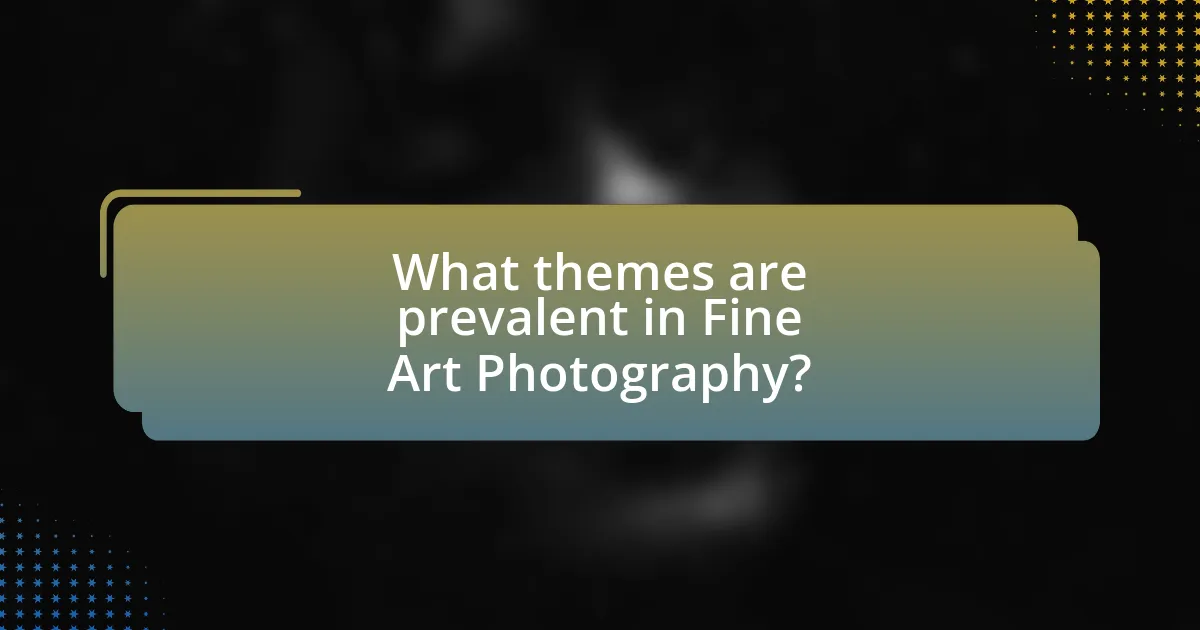
What themes are prevalent in Fine Art Photography?
Prevalent themes in Fine Art Photography include identity, nature, abstraction, and social commentary. Identity explores personal and cultural narratives, often reflecting the photographer’s background or societal issues. Nature captures the beauty and complexity of the natural world, emphasizing environmental concerns. Abstraction focuses on form, color, and texture, inviting viewers to interpret images subjectively. Social commentary addresses contemporary issues, provoking thought and discussion. These themes are supported by numerous exhibitions and publications that highlight their significance in the art world, such as the “New Photography” series at the Museum of Modern Art, which showcases diverse artistic expressions.
How do personal experiences influence themes in Fine Art Photography?
Personal experiences significantly shape themes in Fine Art Photography by providing unique perspectives and emotional depth. Photographers often draw from their own life events, cultural backgrounds, and personal struggles, which inform their artistic choices and subject matter. For instance, a photographer who has experienced loss may explore themes of grief and memory through their work, using visual elements that evoke those emotions. This connection between personal narrative and artistic expression is evident in the works of renowned photographers like Francesca Woodman, whose personal experiences with identity and isolation deeply influenced her haunting imagery. Such examples illustrate how individual experiences can lead to the creation of powerful, resonant themes in Fine Art Photography.
What are some common themes explored by Fine Art Photographers?
Fine art photographers commonly explore themes such as identity, nature, abstraction, and social commentary. Identity is often examined through self-portraits and representations of culture, reflecting personal and collective experiences. Nature is frequently depicted to evoke emotions or highlight environmental issues, showcasing the relationship between humanity and the natural world. Abstraction allows photographers to focus on form, color, and texture, inviting viewers to interpret images subjectively. Social commentary addresses societal issues, using photography as a medium to provoke thought and inspire change. These themes are supported by the works of renowned photographers like Cindy Sherman, Ansel Adams, and Gregory Crewdson, who have each made significant contributions to these areas within fine art photography.
How can symbolism enhance the narrative in Fine Art Photography?
Symbolism enhances the narrative in Fine Art Photography by providing deeper layers of meaning that engage viewers on an emotional and intellectual level. Through the use of symbols, photographers can convey complex ideas, themes, and emotions that might not be immediately apparent in a straightforward image. For instance, a photograph featuring a wilting flower can symbolize decay or loss, prompting viewers to reflect on themes of mortality or change. This technique allows artists to communicate their intentions more effectively, as evidenced by the work of photographers like Gregory Crewdson, who often employs symbolic elements to create narratives that explore the human condition. By integrating symbolism, Fine Art Photography transcends mere representation, inviting viewers to interpret and connect with the artwork on a more profound level.
What role does emotion play in Fine Art Photography?
Emotion plays a crucial role in Fine Art Photography by serving as a vehicle for expression and connection between the artist and the viewer. This emotional engagement allows photographers to convey personal narratives, evoke feelings, and provoke thought through their imagery. For instance, studies have shown that photographs that elicit strong emotional responses can enhance viewer engagement and interpretation, as seen in the works of renowned photographers like Ansel Adams and Cindy Sherman, who effectively use emotion to deepen the impact of their art.
How can Fine Art Photography evoke emotional responses from viewers?
Fine Art Photography can evoke emotional responses from viewers by utilizing composition, lighting, and subject matter to convey deeper meanings and feelings. The careful arrangement of elements within a photograph can create tension or harmony, influencing how viewers emotionally connect with the image. For instance, high-contrast lighting can evoke drama, while soft, diffused light may elicit calmness. Additionally, the choice of subject matter—such as portraits that capture vulnerability or landscapes that evoke nostalgia—can trigger personal memories and emotions. Research indicates that visual stimuli can activate emotional centers in the brain, reinforcing the idea that well-crafted photographs resonate on a psychological level, leading to varied emotional experiences among viewers.
What techniques can photographers use to convey emotion in their work?
Photographers can convey emotion in their work through techniques such as composition, lighting, color, and subject matter. Composition involves arranging elements within the frame to guide the viewer’s eye and evoke feelings; for example, using leading lines can create a sense of movement or tension. Lighting plays a crucial role, as soft, diffused light can evoke calmness, while harsh shadows can create drama. Color also significantly impacts emotion; warm colors like red and orange can evoke passion, while cool colors like blue can convey sadness. Lastly, the choice of subject matter, such as capturing candid moments or intimate portraits, can elicit strong emotional responses from viewers. These techniques are widely recognized in photography literature, emphasizing their effectiveness in emotional expression.
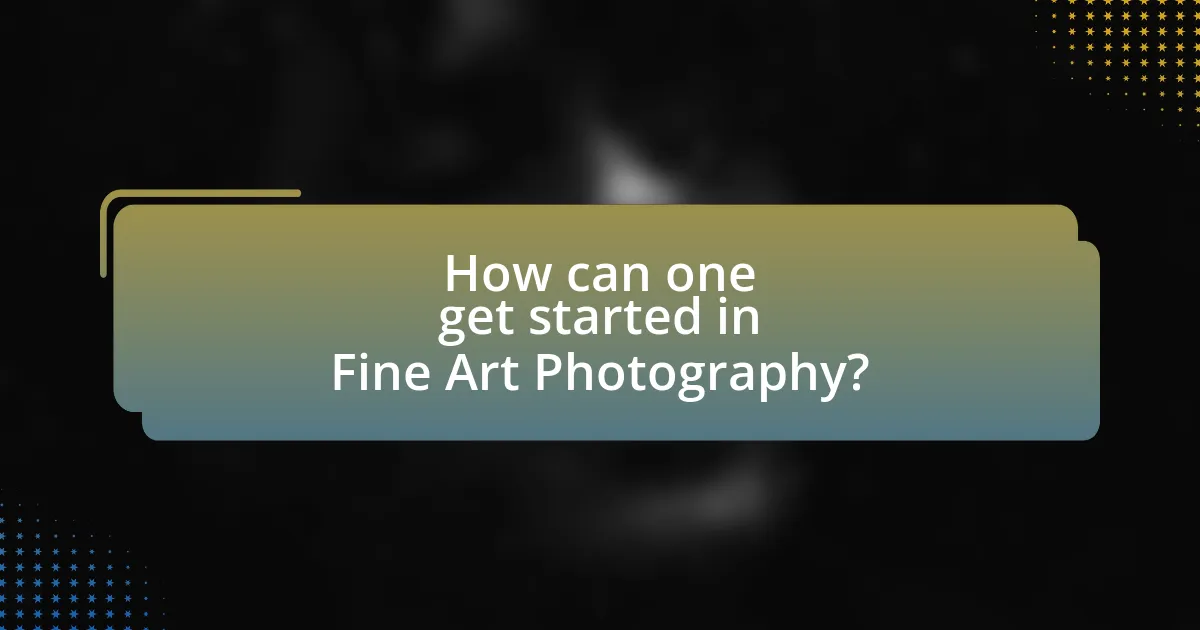
How can one get started in Fine Art Photography?
To get started in Fine Art Photography, one should first develop a strong understanding of artistic concepts and techniques. This involves studying the works of established fine art photographers, experimenting with different styles, and practicing composition, lighting, and post-processing skills. Engaging in workshops or online courses can provide structured learning and feedback. Additionally, creating a portfolio that showcases a personal artistic vision is essential, as it helps in defining one’s unique style and attracting potential audiences or galleries. According to a survey by the Professional Photographers of America, 70% of successful photographers emphasize the importance of continuous learning and portfolio development in their careers.
What equipment is essential for Fine Art Photography?
Essential equipment for Fine Art Photography includes a high-quality camera, a selection of lenses, a sturdy tripod, and proper lighting tools. A high-quality camera, such as a full-frame DSLR or mirrorless model, allows for superior image quality and detail, which is crucial in fine art photography. A variety of lenses, including prime and zoom options, enables photographers to capture different perspectives and compositions. A sturdy tripod is essential for stability, especially in low-light conditions or when using long exposure techniques. Proper lighting tools, such as softboxes or reflectors, help to control and enhance the lighting in a scene, allowing for more artistic expression. These elements collectively contribute to the creation of compelling fine art photographs.
How does camera choice impact Fine Art Photography outcomes?
Camera choice significantly impacts Fine Art Photography outcomes by influencing image quality, depth of field, and creative expression. Different cameras, such as DSLRs, mirrorless systems, and medium format cameras, offer varying sensor sizes and resolutions, which directly affect the detail and clarity of the final image. For instance, medium format cameras typically provide higher resolution and dynamic range, allowing for more intricate details and tonal variations, which are crucial in fine art contexts. Additionally, the choice of lens, which is often determined by the camera system, affects perspective and depth of field, enabling photographers to create specific artistic effects. Studies have shown that the technical specifications of a camera can enhance or limit a photographer’s ability to realize their artistic vision, thereby shaping the overall outcome of their work.
What accessories can enhance the Fine Art Photography experience?
Tripods, high-quality lenses, and neutral density filters can enhance the Fine Art Photography experience. Tripods provide stability for long exposure shots, ensuring sharp images, especially in low light conditions. High-quality lenses improve image clarity and color accuracy, which are crucial for capturing fine details in art photography. Neutral density filters allow photographers to control exposure without affecting color balance, enabling creative effects such as smooth water surfaces or motion blur in clouds. These accessories are essential for achieving professional results in Fine Art Photography.
What are some tips for developing a personal style in Fine Art Photography?
To develop a personal style in Fine Art Photography, photographers should focus on consistent themes, techniques, and emotional expressions that resonate with their vision. Identifying a specific subject matter or concept that inspires you can help create a cohesive body of work. Additionally, experimenting with different techniques, such as lighting, composition, and post-processing, allows for the discovery of unique visual language. Analyzing the work of influential photographers can provide insights into various styles and techniques, aiding in the development of one’s own aesthetic. Engaging in regular practice and seeking constructive feedback from peers can further refine and solidify a personal style.
How can experimentation lead to a unique artistic voice?
Experimentation can lead to a unique artistic voice by allowing artists to explore diverse techniques, materials, and concepts that differentiate their work from others. Engaging in various forms of experimentation, such as manipulating light, composition, or post-processing methods, enables artists to discover new perspectives and styles that resonate with their personal vision. For instance, photographers who experiment with unconventional camera settings or alternative printing processes often develop distinctive aesthetics that set their work apart in the fine art photography landscape. This process of trial and error fosters innovation and self-discovery, ultimately contributing to the formation of an individual artistic identity.
What role does critique play in refining one’s Fine Art Photography skills?
Critique plays a crucial role in refining one’s Fine Art Photography skills by providing constructive feedback that highlights strengths and areas for improvement. This feedback allows photographers to gain new perspectives on their work, which can lead to enhanced creativity and technical proficiency. Studies have shown that artists who engage in critique sessions often experience accelerated growth in their skills, as they learn to analyze their own work critically and adapt based on external insights. For instance, a survey conducted by the College Art Association found that 85% of artists reported significant improvement in their work after participating in peer critiques, underscoring the importance of this practice in artistic development.
What are the best practices for showcasing Fine Art Photography?
The best practices for showcasing Fine Art Photography include selecting high-quality prints, using appropriate framing, and creating a cohesive presentation. High-quality prints ensure that the details and colors of the artwork are accurately represented, which is essential for viewer appreciation. Appropriate framing enhances the visual appeal and protects the artwork, while a cohesive presentation, such as a well-organized gallery or exhibition space, allows viewers to engage with the work in a meaningful way. Research indicates that well-curated exhibitions can increase viewer engagement by up to 50%, highlighting the importance of presentation in the art world.
How can photographers effectively present their work in galleries?
Photographers can effectively present their work in galleries by focusing on the arrangement, lighting, and narrative of their pieces. Proper arrangement involves creating a cohesive flow that guides viewers through the exhibition, often by grouping works thematically or by series. Effective lighting enhances the visual impact of photographs, ensuring that colors and details are accurately represented, which is crucial for maintaining the integrity of the artwork. Additionally, establishing a narrative through the selection and presentation of images can engage viewers on a deeper level, encouraging them to connect emotionally with the work. Research indicates that well-curated exhibitions can increase viewer engagement and appreciation, as seen in studies conducted by the Museum of Modern Art, which highlight the importance of context in art presentation.
What online platforms are best for sharing Fine Art Photography?
The best online platforms for sharing Fine Art Photography are Instagram, 500px, and Flickr. Instagram allows photographers to reach a broad audience through visual storytelling and hashtags, making it a popular choice for showcasing art. 500px is specifically designed for photographers, offering a community focused on high-quality images and opportunities for exposure. Flickr provides a platform for photographers to share their work in organized albums and engage with a community of enthusiasts. Each platform has unique features that cater to the needs of Fine Art photographers, enhancing visibility and interaction with their art.
What resources are available for aspiring Fine Art Photographers?
Aspiring Fine Art Photographers can access various resources, including online courses, workshops, photography books, and community forums. Online platforms like Skillshare and MasterClass offer structured courses taught by experienced photographers, while workshops provide hands-on experience and networking opportunities. Books such as “The Photographer’s Eye” by Michael Freeman and “Understanding Exposure” by Bryan Peterson offer foundational knowledge and techniques. Additionally, community forums like Reddit’s r/photography and specialized Facebook groups allow photographers to share work, receive feedback, and connect with peers. These resources collectively support skill development and artistic growth in fine art photography.
How can workshops and courses enhance Fine Art Photography skills?
Workshops and courses enhance Fine Art Photography skills by providing structured learning environments that facilitate skill development and artistic growth. These educational settings offer hands-on experience, expert guidance, and constructive feedback, which are crucial for mastering technical aspects such as composition, lighting, and post-processing. For instance, a study by the National Endowment for the Arts found that participation in arts education programs significantly improves creative skills and artistic expression. Additionally, workshops often foster networking opportunities with peers and professionals, allowing for collaboration and inspiration that can further refine an artist’s unique style.
What books and online resources are recommended for learning Fine Art Photography?
Books recommended for learning Fine Art Photography include “The Photographer’s Eye” by Michael Freeman, which emphasizes composition and visual storytelling, and “On Photography” by Susan Sontag, offering critical insights into the medium’s cultural implications. Online resources include the website CreativeLive, which provides courses on fine art photography techniques, and the YouTube channel of the Art of Photography, featuring tutorials and discussions on artistic approaches. These resources are widely recognized in the photography community for their educational value and practical guidance.










